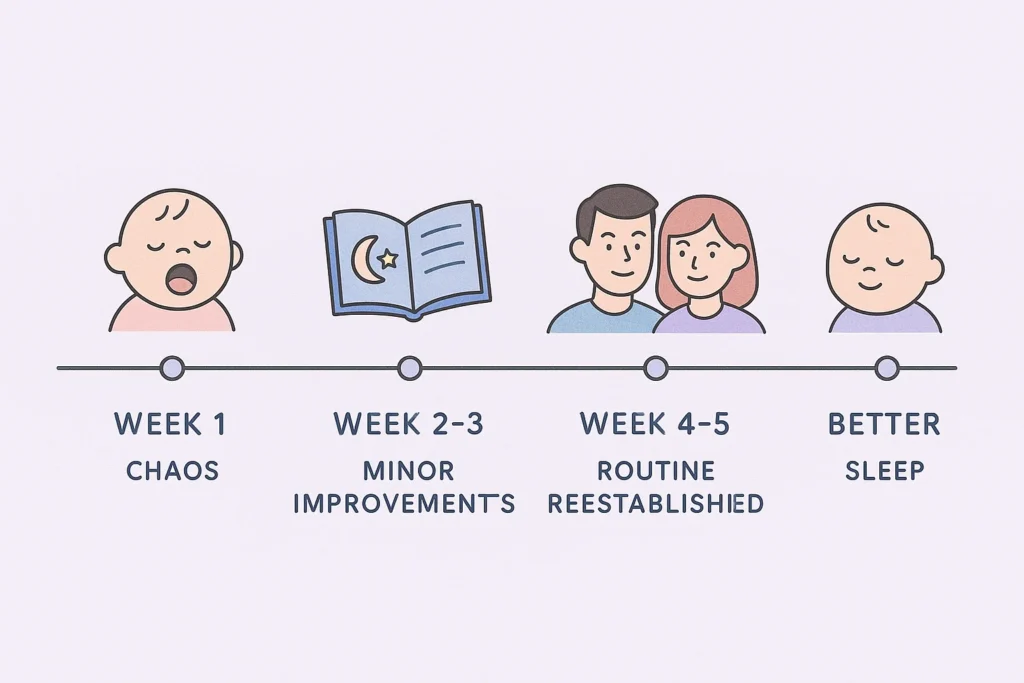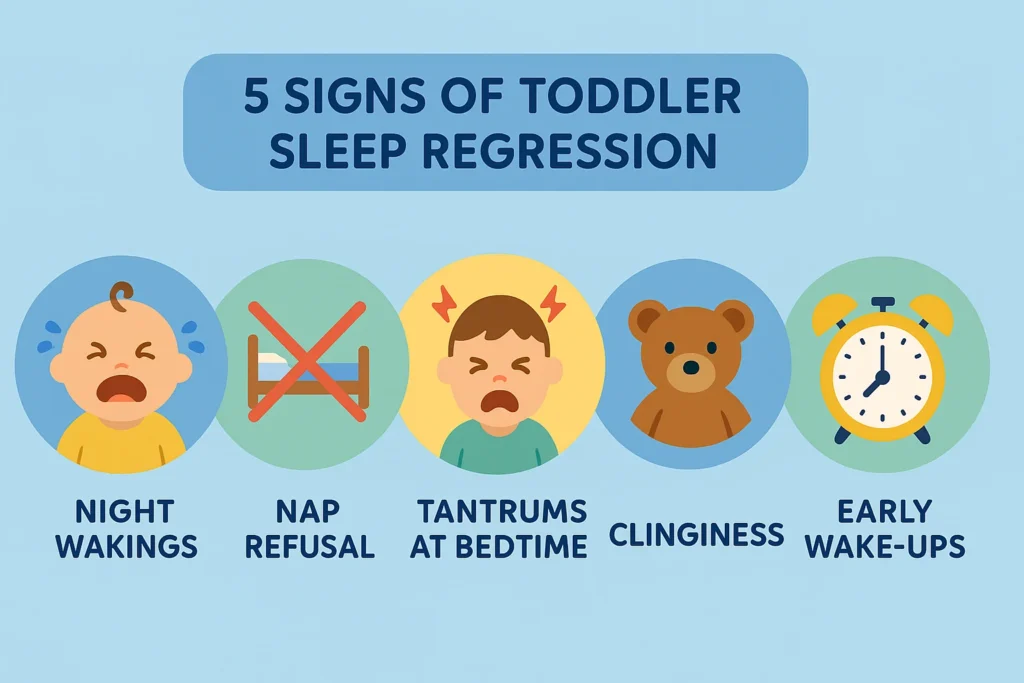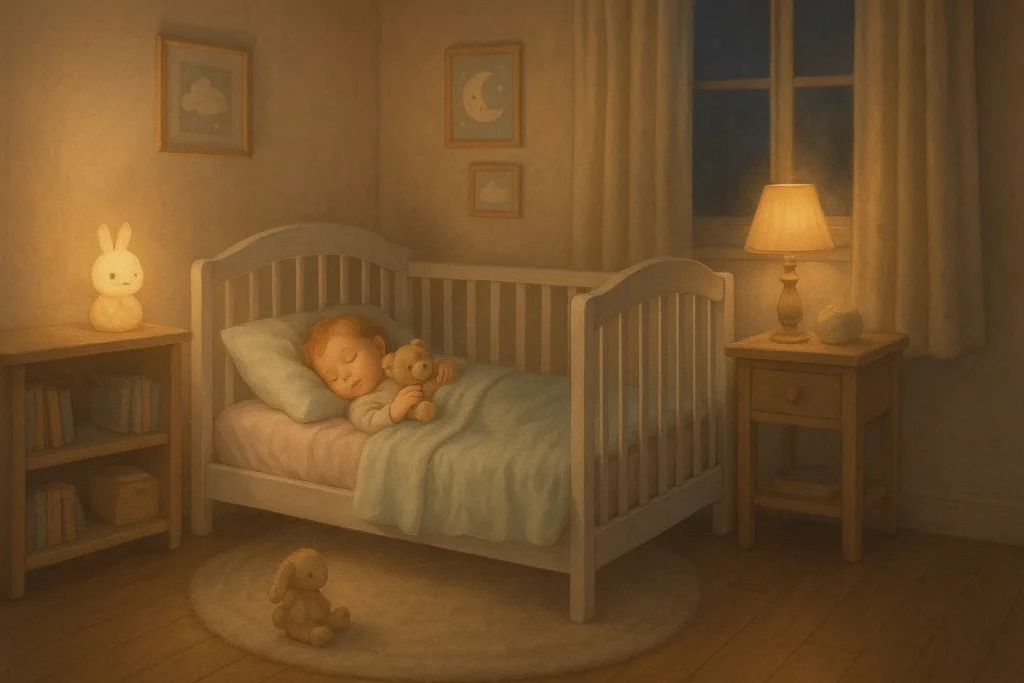The 18-month sleep regression often hits like a sudden, relentless wave. One moment, your toddler is peacefully sleeping through the night — the next, they’re waking multiple times, crying for you, refusing naps, and turning bedtime into a battle.
If you’re asking questions like “Why is my 18-month-old not sleeping?” or “Is there an 18-month sleep regression?”, you’re not alone. This phase is widespread, frustrating, and, thankfully, temporary.
In this in-depth 2025 guide, you’ll discover everything you need to know about the 18-month sleep regression — its causes, key signs, survival strategies, common mistakes, nutrition tips, when to seek help, and real-life success stories from parents who’ve been there. With expert advice and actionable plans, you’ll be better equipped to help your family get back to restful nights.
Table of Contents
What is the 18-Month Sleep Regression?
The 18-month sleep regression is a well-documented developmental phase where toddlers who previously slept well suddenly experience significant sleep disruptions. Typically occurring between 17 and 19 months of age, this sleep regression can catch families off guard. Parents often find themselves wondering, “Why is my 18-month-old waking up crying at night?” or “Why won’t my 18-month-old sleep anymore?”
A noticeable change in sleep behavior marks this period, and it’s often frustrating because toddlers who had been sleeping through the night without issues suddenly start resisting sleep altogether. The 18-month sleep regression can leave both toddlers and parents feeling exhausted, confused, and desperate for solutions.
Why Is It Called a “Regression“?
The term “regression” is used because it feels like your child is taking a step backward in their sleep development. Instead of continuing to build on good sleep habits, your toddler might:
- Struggle to fall asleep at bedtime
- Wake up frequently throughout the night
- Become clingier and demand more parental presence to fall asleep
- Wake up earlier in the morning, usually between 5:00 and 6:00 a.m.
These changes mirror earlier sleep challenges experienced during infancy. Still, now they come with an extra layer of toddler independence, emotional outbursts, and developmental leaps that make the situation even more complex.
In reality, this 18-month sleep regression signals progress, not failure. It reflects your child’s growing brain, emotional needs, and newfound desire for independence. However, knowing it’s “normal” doesn’t make it easier to manage without the right strategies.
Common Behaviors During the 18-Month Sleep Regression
While every child may react a bit differently, several hallmark signs often point clearly to the 18-month sleep regression:
1. Multiple Night Wakings
A toddler who previously slept 10–12 hours straight may now wake up multiple times throughout the night, crying or calling out for a parent. This is one of the most distressing signs for exhausted families.
2. Nap Resistance or Skipping Naps
Daytime sleep also takes a hit during the 18-month sleep regression. Toddlers may outright refuse naps, take much shorter naps than usual, or seem wired even when they are overtired.
Important:
This doesn’t mean your toddler no longer needs naps. Most 18-month-olds still require 1.5–2.5 hours of daytime sleep.
3. Longer Time to Settle at Bedtime
Bedtime routines that once took 15 minutes may now drag out for an hour or more. Your toddler may stall, ask for more books, cry when you leave the room, or physically resist getting into bed.
4. Crying and Screaming When Put Down
Many parents report that during the 18-month sleep regression, their child starts screaming the moment they are placed in the crib. This behavior often stems from a surge in separation anxiety and a desire for control.
5. Needing a Parent to Fall Asleep
Independent sleepers might suddenly insist that you stay in the room until they fall asleep — and even cry out for you multiple times overnight. This behavior can quickly become a new habit if not managed carefully during this regression.
6. Early Morning Wakings (5:00–6:00 a.m)
If your 18-month-old is suddenly waking up for the day at 5:00 a.m., you’re not alone. Early rising is a classic symptom of the 18-month sleep regression and is often associated with disrupted sleep cycles and feeling overtired.
Why Understanding the 18-Month Sleep Regression Matters
Recognizing that these sleep challenges are part of normal development — and not a permanent setback — is essential for both emotional well-being and effective action. The 18-month sleep regression is temporary, but if not handled correctly, it can lead to longer-term sleep associations and habits that are difficult to break later.
By staying calm, consistent, and patient, you can help your toddler navigate the regression with fewer tears (for everyone!) and restore healthy sleep habits sooner, rather than later.
Why Does the 18-Month Sleep Regression Happen?

Several massive developmental shifts happen at once during toddlerhood, causing brain overload and sleep disruption.
1. Cognitive and Physical Growth Spurts
Toddlers at 18 months are learning:
- Dozens of new words every week
- Running, climbing, throwing, stacking
- Solving fundamental problems and puzzles
Their brains are hyperactive, practicing skills even during sleep cycles.
Expert Insight:
“Cognitive surges often ‘wake up’ the brain even when it should be resting. This causes short sleep cycles and frequent night wakings.” — Dr. Harvey Karp, Pediatrician and Author of Happiest Baby on the Block.
Example:
You put your toddler down at 8 p.m., but instead of sleeping, they’re practicing saying “uh-oh” and “no” over and over.
2. Separation Anxiety Resurgence
At this stage, toddlers start to understand that you can leave — and they worry you might not come back.
Real-life Scenario:
Even if they were fine six weeks ago, now they scream every time you leave the room.
✅ Pro Tip:
Create a consistent, calm “goodbye ritual” every night (“Night-night, see you in the morning!”) to build emotional security.
3. Independence and Limit Testing
This age marks the explosion of the “I do it myself!” phase — including sleep.
Behavior checklist:
- Stalling at bedtime
- Demanding multiple goodnight kisses
- Getting out of bed repeatedly
- Saying “NO!” loudly and repeatedly
🎯 Parent Strategy:
Offer limited choices to empower them without giving up control:
“Do you want mommy or daddy to tuck you in tonight?”
4. Pain from Teething
Second molars (the most prominent teeth) often start cutting through between 16 and 24 months.
Signs of teething:
- Drooling
- Chewing on fingers
- Irritability at meals
- Pulling on ears (sometimes mistaken for ear infections)
🛠️ Solutions:
- Offer safe, chilled teething toys
- Use pediatrician-approved teething pain relievers if necessary
Key Signs of the 18-Month Sleep Regression

If your once soundly sleeping toddler suddenly begins resisting naps, waking throughout the night, and clinging to you like never before, you might be asking yourself:
“Is this really the 18-month sleep regression — or is something else wrong?”
It’s a smart question. Recognizing the key signs of the 18-month sleep regression helps you take the right approach, providing support without accidentally creating long-term sleep issues.
Let’s break down the clear indicators that your child is facing the 18-month sleep regression, not another sleep disorder.
1. Sudden Sleep Changes in a Previously Good Sleeper
One of the most obvious signs of the 18-month sleep regression is an abrupt change in sleep habits.
If your toddler was previously sleeping through the night — falling asleep independently and staying asleep for 10 to 12 hours — and now suddenly struggles, it’s a strong sign of developmental regression.
Common sleep disruptions include:
- Prolonged bedtime battles
- Frequent waking up at night
- Early rising (5:00–6:00 a.m.)
✅ Important:
If these issues start suddenly around 17–19 months without illness, travel, or significant life changes, it’s almost certainly the 18-month sleep regression.
2. Increased Clinginess and Extreme Fussiness During the Day
Many parents notice that sleep issues aren’t the only challenge — daytime behavior often changes too.
During the 18-month sleep regression, toddlers may become unusually clingy. Even typically independent children might:
- Cry when separated from parents
- Insist on being held constantly
- Have meltdowns when routines change
This separation anxiety surge is developmentally appropriate but frustrating, especially when paired with overtiredness.
Real-life Example:
A toddler who previously ran into daycare happily might suddenly cry at drop-off and cling to the parent’s leg.
3. Shortened or Skipped Naps
Nap trouble is another hallmark of the 18-month sleep regression.
Toddlers who used to take consistent 1.5–2-hour naps may:
- Refuse to nap altogether
- Take much shorter naps (30–45 minutes)
- Cry and fight during nap time for long periods
Important to know:
Skipping naps does not mean your 18-month-old no longer needs daytime sleep. Most toddlers at this age still require 12–14 total hours of sleep every day, including naps.
✅ Tip:
Continue offering a nap opportunity daily, even if it results in quiet rest time on some days rather than actual sleep.
4. Multiple Night Wakings for Reassurance
Perhaps the most exhausting sign of the 18-month sleep regression is frequent night waking.
Your toddler may:
- Wake up every 1–2 hours
- Cry loudly until you come into the room
- Demand cuddles, rocking, or your physical presence to return to sleep
This behavior stems partly from developmental leaps in memory and emotional awareness — they realize you’re not there and feel anxiety about it.
📌 Pro Tip:
Respond briefly and calmly, offering reassurance without creating new sleep dependencies, such as rocking to fall asleep every time.
5. General Mood Swings and Heightened Separation Anxiety
Emotional regulation is still developing at 18 months, making toddlers prone to dramatic mood swings, especially when they are tired.
Common behaviors during the 18-month sleep regression include:
- Sudden tantrums over minor frustrations
- Crying when handed to a caregiver
- Increased fearfulness (e.g., being afraid of the dark)
These emotional changes can affect both daytime behavior and nighttime sleep, creating a cycle where poor sleep worsens emotional regulation, and vice versa.
How to Confirm It’s the 18-Month Sleep Regression (and Not Something Else)
✅ If your toddler was previously a good sleeper, and you notice a sudden onset of the signs listed above, around the 17 to 19-month window, it’s very likely the 18-month sleep regression.
These sleep disturbances are regular and temporary, triggered by massive developmental growth, not by parenting mistakes or permanent problems.
However, if symptoms are accompanied by a persistent fever, significant pain, wheezing, or severe behavioral changes, it’s wise to consult a pediatrician to rule out any medical issues.
Summary
Recognizing the key signs of the 18-month sleep regression early allows you to respond with patience, consistency, and confidence.
Stay calm, maintain loving boundaries, protect naps, and remember:
✨ This regression is a sign of healthy development, and it will pass.
How to Handle an 18-Month Sleep Regression (Step-by-Step Guide)

Surviving the 18-month regression requires a combination of empathy, structure, and innovative strategies.
Here’s your complete step-by-step plan:
Step 1: Stick to a Familiar Bedtime Routine
A consistent, calming routine anchors your toddler emotionally and mentally.
Sample Bedtime Routine (30–45 minutes):
- Dinner (around 6 p.m)
- Bath time — warm bath with dim lights
- Quiet play — puzzles, soft blocks, drawing (no screens)
- Books — 2–3 favorite bedtime stories
- Snuggles and Goodnight Ritual — consistent phrases like “See you in the morning!”
📖 Bonus Tip:
Choose books with calming rhythms like Goodnight Moon or Time for Bed to signal sleep.
Step 2: Offer Comfort While Encouraging Independence
It’s essential to respond to night wakings, but without creating new dependencies like rocking them to sleep every time.
Recommended Approach:
- Go in briefly.
- Offer calm verbal reassurance: “Shhh, time for sleep.”
- Gently pat their back if needed — only pick them up if necessary.
- Leave before they fall asleep, encouraging them to self-soothe.
Technique:
Use the “Gradual Retreat” method — start by sitting next to the crib, and each night move a little further away.
Step 3: Protect Daytime Sleep
Naps are a struggle every day during regressions, but toddlers still need naps at 18 months.
Checklist for Nap Success:
- Nap start time: between 12:00 and 1:00 p.m.
- Duration: 1.5–2.5 hours
- Nap environment: dark, quiet, white noise
- Be patient — some days they may fight it, but the offer should always remain.
🛑 Warning:
Skipping naps can create an overtired cycle that worsens nighttime sleep issues.
Step 4: Set Firm but Loving Boundaries
Toddlers thrive when they know the limits are clear and loving.
✅ Examples of Bedtime Rules:
- “After storytime, lights go off.”
- “We say goodnight once, then it’s sleep time.”
- “No getting out of bed until morning.”
📢 Pro Parenting Tip:
Use a toddler clock, like the Hatch or GroClock, to visually show when it’s time to wake up.
Step 5: Prioritize Comfort — But Avoid Overreaction
If your toddler wakes up scared or crying:
- Respond briefly and calmly.
- Resist the urge to turn on all the lights or engage fully (this can stimulate the brain).
- Avoid bringing them into your bed unless you want to co-sleep in the long term.
🎯 Goal:
Help them feel safe, without disrupting your ultimate sleep goals.
Common Mistakes to Avoid During the 18-Month Sleep Regression

The 18-month sleep regression is challenging enough without making it worse accidentally. Many well-meaning parents, driven by exhaustion and desperation, unintentionally reinforce sleep difficulties during this period.
Being aware of common mistakes can help you avoid falling into these traps — and make the regression phase shorter and less painful for both you and your toddler.
Here’s what to watch out for during the 18-month sleep regression:
1. Bedtime Creep: Letting Bedtime Get Too Late
One of the biggest mistakes parents make during the 18-month sleep regression is pushing bedtime later, thinking that it will tire their toddler out enough to make them fall asleep faster.
In reality, later bedtimes usually have the opposite effect. When toddlers become overtired, their bodies produce a surge of stress hormones, such as cortisol and adrenaline, making it even harder for them to settle down, fall asleep, and stay asleep.
Common signs of overtiredness include:
- Hyperactivity before bed (running, laughing uncontrollably, bouncing off furniture)
- Meltdowns during bedtime routine
- Difficulty falling asleep, even though visibly exhausted
- Early morning wake-ups (before 6 a.m)
📌 Ideal Bedtime:
For most toddlers, the best bedtime falls between 7:00 p.m. and 8:00 p.m. — even if they seem wide awake. Remember: wired = overtired.
✅ Pro Tip:
Start your calming bedtime routine about 45–60 minutes before your child’s target bedtime to allow them to transition gradually into a sleepy state.
Example:
If you want a 7:30 p.m. bedtime, begin the wind-down routine no later than 6:45 p.m.
2. Inconsistent Responses to Night Wakings
During the 18-month sleep regression, toddlers often wake multiple times at night looking for reassurance. One night, you might rush in immediately; the next, you might let them cry it out longer because you’re too exhausted. Unfortunately, this inconsistency can be very confusing for toddlers.
Inconsistent responses create uncertainty and anxiety. Your toddler doesn’t know what to expect, which can lead to:
- Increased crying
- Longer wakeful periods at night
- Stronger resistance at bedtime
✅ Pro Tip:
Pick a calm, middle-ground approach — and stick to it consistently every night.
Recommended approach for the 18-month sleep regression:
- Respond briefly and calmly when your child wakes.
- Use a predictable reassurance phrase, like “It’s still nighttime.”
- Offer minimal touch or stimulation (such as patting back or whispering).
- Leave before your child falls fully asleep to encourage them to settle independently.
Real-life example:
Monica, a mom of an 18-month-old boy, found that consistently doing a quick, calm check-in every 5–7 minutes helped her son learn to self-settle again within two weeks.
3. Offering Too Much Help (Creating New Sleep Crutches)
During regressions, it’s natural to want to comfort your distressed toddler. However, creating new sleep associations — like rocking to sleep, feeding to sleep, or sleeping in the same bed — can make the 18-month sleep regression last longer.
Your toddler might come to rely on these props to fall asleep, turning temporary sleep struggles into ongoing sleep dependencies that persist well beyond the regression.
📌 Warning Signs of Sleep Crutches:
- Needing to be rocked to sleep every night
- Demanding bottles or nursing multiple times overnight
- Screaming if a parent leaves the room before they’re fully asleep
✅ Solution:
Offer emotional support without introducing new sleep habits that you don’t want to keep long-term.
🎯 Key Strategy:
Help your toddler fall asleep in their own sleep space with minimal intervention after the initial comfort.
4. Giving Up on Naps Too Early
During the 18-month sleep regression, nap resistance is common, but it doesn’t mean your toddler is ready to drop naps completely.
Everyday nap struggles include:
- Fighting is going down for naps
- Taking shorter naps than usual
- Refusing naps for a few days in a row
Toddlers still need one solid nap daily — typically around 1.5 to 2.5 hours — until they are at least 3 years old.
🛑 Mistake to avoid:
Assuming a few bad nap days means they don’t need naps anymore and removing naps altogether. This can backfire, making nighttime sleep even worse due to overtiredness.
✅ Nap Survival Tips During the 18-Month Regression:
- Continue offering a nap opportunity at the same time every day.
- Keep the nap environment dark, quiet, and soothing.
- If they refuse to nap, still enforce quiet rest time.
Remember:
Persistence and consistency help toddlers re-establish napping habits even during regressions.
Overusing Sleep Props
New habits, like feeding back to sleep or driving around in the car at 2 a.m., seem helpful in the short term, but they create dependency.
Dropping Naps Too Early
Just because your toddler resists napping doesn’t mean they’re ready to quit.
At 18 months, most children still need one nap a day for healthy growth and development.
How Nutrition Impacts Sleep During Regressions
Believe it or not, what (and when) your toddler eats directly impacts their sleep quality!
1. Balanced Daily Meals
- Whole foods: veggies, fruits, proteins, whole grains
- Minimize processed sugars and junk foods
- Include magnesium-rich foods (like bananas and leafy greens) for better relaxation
2. Proper Meal Timing
- Dinner: Finish at least 2 hours before bedtime
- Pre-bed snack: A small healthy snack if they seem hungry (ex, yogurt, cheese, whole-grain crackers)
3. Hydration Strategy
- Encourage water throughout the day.
- Limit fluids 1 hour before bedtime to avoid extra wake-ups.
4. Foods That Support Sleep
Good choices:
- Bananas
- Oatmeal
- Greek yogurt
- Turkey
- Almonds
Avoid before bed:
- Sugary snacks
- Chocolate (contains caffeine)
How Long Does the 18-Month Sleep Regression Last?
Good news:
It’s temporary!
Typical Timeline:
- Week 1–2: Roughest phase — multiple night wakings
- Week 3–4: Improvement begins — naps are more predictable
- Week 5–6: Return to baseline sleep (or even better!)
⏳ Average total duration: 3–6 weeks.
✅ Consistent routines significantly shorten regression duration!
When to Seek Help from a Sleep Consultant or Pediatrician

You may need professional support if:
- Sleep problems persist longer than 6–8 weeks
- Toddler snores loudly, gasps, or has labored breathing (possible sleep apnea)
- Severe separation anxiety that disrupts daily functioning
- No improvement despite structured routines
🔗 External Trusted Resource: HealthyChildren.org Sleep Guidelines
Real Parent Experiences: What Worked for Us

Case Study 1: “Routine Wins!”
“After a few brutal nights, we went back to basics: same bath-book-bed every night. By week three, my son started sleeping 10–11 hours again.” — Monica T., Seattle.
Case Study 2: “Nap Persistence”
“I was tempted to drop naps because my daughter refused them for days. But staying firm with nap routines eventually helped nights improve too.” — Derek R., London.
Case Study 3: “Teething Relief”
“When teething flared up, using chilled silicone teethers before bed made a huge difference — fewer night wakeups.” — Priya S., New York City
Advanced Tips for a Smoother Sleep Transition
Looking for bonus strategies? Here’s what top sleep consultants recommend:
✅ Introduce a “special bedtime toy” — A new cuddly friend can offer security.
✅ Use visual schedules — Toddlers love routine charts with simple pictures for activities like bathing, brushing teeth, reading books, and going to sleep.
✅ Play “separation games” during the day — Peekaboo and Hide-and-Seek help build trust that you’ll return.
✅ Control the environment — a cool room temperature (68–72°F), a white noise machine, and complete darkness.
✅ Stay positive — Celebrate small wins like “Tonight you slept in your bed!” even if they still woke up once.
FAQ About 18-Month Sleep Regression
Is there an 18-month sleep regression?
Yes! It’s a recognized developmental sleep disturbance triggered by brain, emotional, and physical growth.
How do I handle my toddler waking at night?
Keep it brief, boring, and consistent. Comfort them with a whisper and pat — avoid stimulating activities.
Should I start sleep training again?
Not right away. Focus first on returning to old routines. If needed after 3–4 weeks, gentle retraining methods are acceptable.
Why does my 18-month-old wake up screaming?
Nightmares, separation anxiety, teething pain, or simple disorientation from waking in a dark room.
Can teething cause sleep regression?
Absolutely — molar teething is very disruptive for many toddlers around this age.
Should I eliminate naps if they fight naps?
No. Maintain at least one daily nap, even if they resist — it’s essential for overall health and a good night’s sleep.
Is sleep regression worse for strong-willed toddlers?
Often yes! High-sensitivity or spirited children may have more intense (but still temporary) regressions.
Conclusion: Your 18-Month Sleep Regression Action Plan
Parenting through sleep regressions is authoritarian — no doubt about it. But you’re not helpless, and you’re not alone.
🎯 Your Action Plan Checklist:
- Stick to consistent bedtime routines
- Offer comfort without creating sleep crutches
- Protect nap time daily
- Maintain clear, loving boundaries
- Watch nutrition and hydration
- Seek help if needed after 6+ weeks
✨ Final Thought:
You are building trust, emotional security, and lifelong sleep habits — even when it doesn’t feel like it tonight.
Hold steady.
Better sleep is closer than you think — for your toddler and you.



